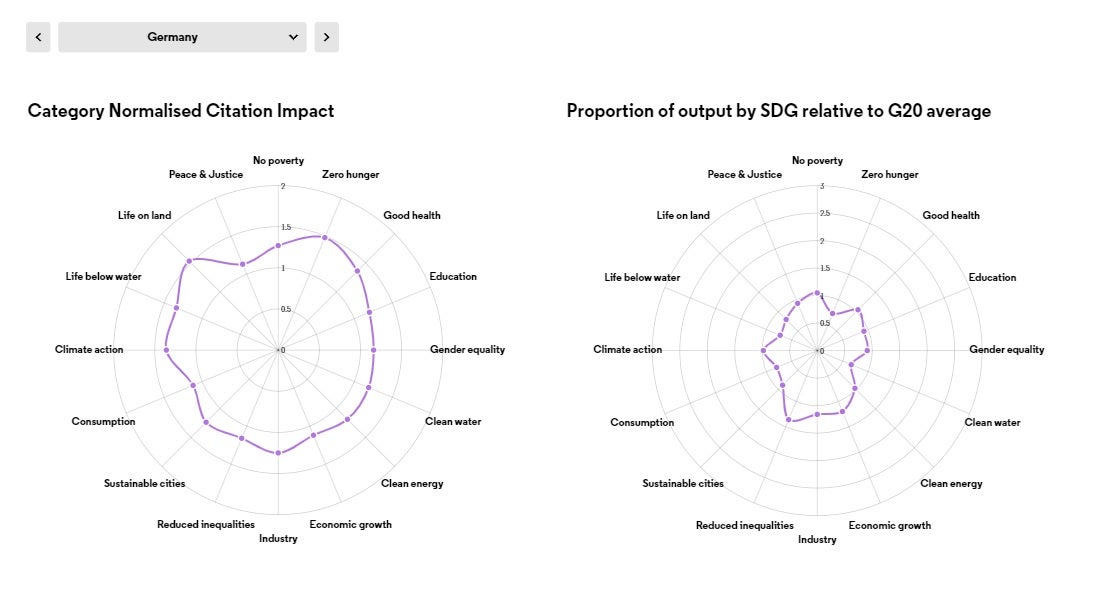We are proud to introduce fresh insights into measuring global research performance via our dynamic G20 scorecard for 2023, newly enhanced with online data visualizations. This guide to understanding the G20 scorecard explores how this interactive tool expands our perspective of global research and innovation.
Each year, prior to the G20 Summit of the heads of state of the member nations, the Institute for Scientific Information (ISI)™ at Clarivate™ releases its annual G20 scorecard. This condenses and compares the research and innovation capabilities of the G20 economies* which are renowned for their significant investments in education, research and technology. It serves as an indispensable resource for professionals across academia, government and industry – individuals who need to understand shifting global research trends to inform strategic planning, investment and decision-making.
This year for the first time, the G20 scorecard’s extensive dataset is presented in dynamic, interactive charts, with filters to make quick comparisons and deep-dive analyses easier than ever. We’ve also published a downloadable executive summary that distils the key findings for 2023 to reveal the stories behind the data.
Breaking down the data
The G20 scorecard arranges the data into five key categories, with a dropdown filter to allow you to explore in depth:
- Figure 1: Context – An overview of the people, financial, intellectual property and bibliometric data for all G20 members (e.g. population, GDP, female researchers, patents, academic papers, etc.), highlighting their diversity and giving context for the other data in the scorecard.
- Figure 2: Impact – The citation impact (measured by Category Normalized Citation Impact, or CNCI) of the papers published by each country/region, presented in both an Impact Profile and the trend for 2013-2022.
- Figure 3: Output – Trends in international output and open access output for 2013-2022 for each G20 member nation.
- Figure 4: Disciplines – Charts the output and impact of each G20 member by discipline together with the trends for 2013-2022.
- Figure 5: SDGs – Displays the impact and output of each G20 member linked to each United Nations Sustainable Development Goal (SDG), normalized and benchmarked against the world or G20 average.
Discovering the stories behind the numbers
One of the most interesting aspects of the G20 scorecard is its ability to reveal the unique stories hidden within the data. Let’s take a glimpse into some of the significant findings from the 2023 edition:
- Mainland China’s innovation leap: With a remarkable patent creation record in 2021, Mainland China is catapulting itself into a position of global innovation leadership.
- United States’ research impact conundrum: Despite being a research giant, the U.S. has witnessed declines in CNCI and Collaborative CNCI over the past decade. This trend beckons a closer exploration into the dynamics of research impact and collaboration.
- Argentina’s collaborative influence in medicine: Argentina’s medical research achievements, buoyed by international collaboration, surpass the global average by a remarkable 1.5 times — a testament to the power of global partnership in driving impactful research.
- Brazil’s embrace of OA humanities: Brazil’s emphasis on open access publication in humanities research sets it apart, sparking discussions about knowledge accessibility and the dissemination of research findings.
- Saudi Arabia’s unique research dynamics: With the highest average CNCI among G20 nations, Saudi Arabia’s research contributions shine, although collaborative CNCI experiences a slight dip, underscoring its individual research prowess.
- India’s research trajectory: Despite outpacing Mainland China in population, India’s research output and GDP fall significantly short, sparking questions about resource allocation and potential future trends.
- Canada’s multifaceted research output: Canada’s above-average research output, but below-average OA output, across diverse categories invites conversations about collaboration patterns and access to research findings.
- United Kingdom’s shift in dissemination strategy: With over half of its output published in open access journals, the U.K. signifies a shift in research dissemination and partnership strategies.
- Russia’s research challenges: Low CNCI and Collaborative CNCI scores hint at Russia’s hurdles in research impact and international collaboration.
- Japan’s gender imbalance and research productivity: Japan’s gender imbalance in research and low research productivity raise important questions about structural issues within its research ecosystem.
A vision for informed collaboration and analysis
The dynamic G20 scorecard is poised to become an invaluable tool for planning, investment and collaboration, offering guidance for strategic decision-making across academia, industry and government. The in-depth analyses and dynamic data reveal a panoramic view of the global research landscape, enabling stakeholders to make informed choices and collaborate effectively for the betterment of society.
At Clarivate, we are committed to bringing clarity to the complex. The dynamic format of the G20 scorecard reflects this commitment, providing governments, funders and research institutions with an interactive benchmark for regional research economies. It empowers them to make critical research planning and strategic investment decisions.
Explore the G20 scorecard to understand its data and insights here: https://clarivate.com/the-institute-for-scientific-information/2023-g20-scorecard
You might also like to read our other ISI reports, or contact our team if you’d like to find out more about how we can help evaluate research at your organization.
*Note: The G20 member nations include Argentina, Australia, Brazil, Canada, China, France, Germany, India, Indonesia, Italy, Japan, Republic of Korea, Mexico, Russia, Saudi Arabia, South Africa, Türkiye, the United Kingdom, and the United States. The 20th member, the EU, is not part of the scorecard analysis.










